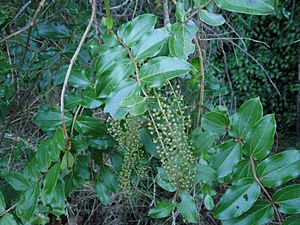Izatha mesoschista facts for kids
Quick facts for kids Izatha mesoschista |
|
|---|---|
 |
|
| Scientific classification | |
| Kingdom: | |
| Phylum: | |
| Class: | |
| Order: | |
| Family: |
Oecophoridae
|
| Genus: | |
| Species: |
I. mesoschista
|
| Binomial name | |
| Izatha mesoschista Meyrick, 1931
|
|
Izatha mesoschista is a type of moth that belongs to the Oecophoridae family. It is only found in New Zealand, meaning it's endemic there.
Contents
How This Moth Got Its Name
This moth was first officially described by a scientist named Edward Meyrick in 1931. He studied seven moth specimens that George Hudson had collected in Wellington during December and January.
Interestingly, George Hudson had already written about and drawn this moth in his 1928 book, The butterflies and moths of New Zealand. However, he thought it was a different species called Izatha balanophora. He later realized his mistake and corrected the name in 1939.
What the Izatha mesoschista Moth Looks Like
We don't know much about the caterpillar (larva) stage of this moth yet.
The adult Izatha mesoschista moths have a wingspan (the distance from one wingtip to the other) of about 15.5 to 21 millimeters for males. Females are a bit larger, with a wingspan of 17 to 25 millimeters. You can usually see these moths flying from October to February.
How to Tell Them Apart
The appearance of these moths can vary a lot, which is why they were sometimes confused with another moth, Izatha balanophora.
However, you can tell I. mesoschista apart because it has a clear black line in the middle of its front wings. This line also helps to tell it apart from Izatha epiphanes.
It can be tricky to tell I. mesoschista from Izatha haumu just by looking at them. A good clue is where they are found: I. haumu lives at the very top of the North Island, while I. mesoschista is found south of that area, across the rest of the North Island.
Male I. mesoschista moths also have a special three-pronged tip on their reproductive parts, which helps scientists tell them apart from I. haumu and I. epiphanes.
Where Izatha mesoschista Lives
I. mesoschista is found only in New Zealand. You can find this moth throughout most of the North Island, but it hasn't been seen in the Aupouri Peninsula, Hawkes Bay, or the Wairarapa. It's considered one of the most common and widespread types of Izatha moths in the North Island.
What Izatha mesoschista Caterpillars Eat
Scientists have found Izatha mesoschista caterpillars living on or eating from several types of plants. They have been found on different kinds of Populus trees (like poplars), usually in dead wood. They also eat pine logs.
Caterpillars of this species have also been found on Coriaria arborea and various Coprosma plants.
How to Find Izatha mesoschista Moths
These moths are easily attracted to light. This means if you set up a light at night, you might be able to spot them!


